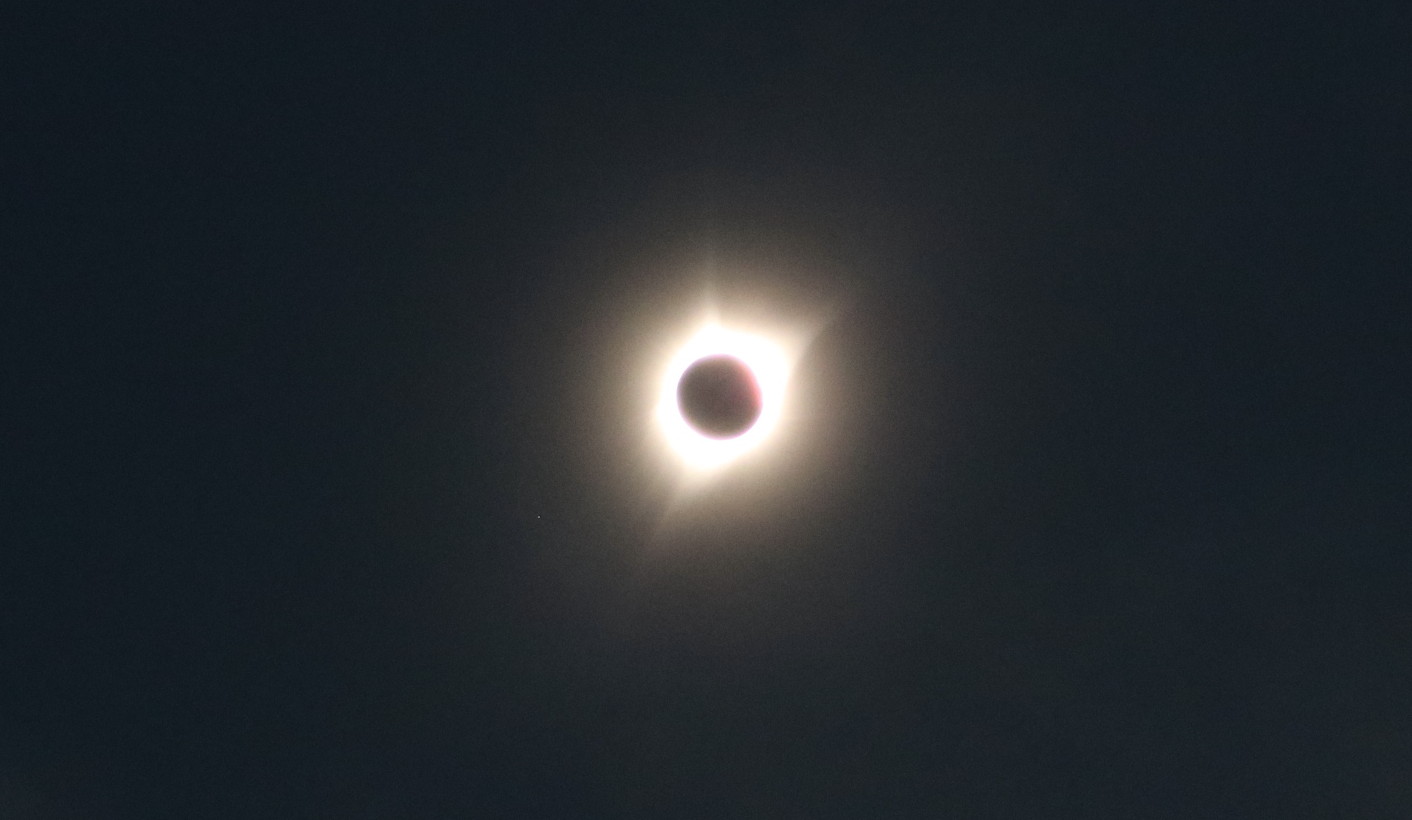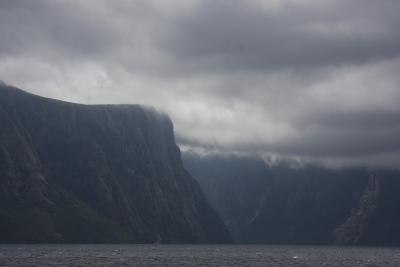A Farewell to Newfoundland
By mid-August we had been in Newfoundland for three weeks. Our final week we explored the Northern Peninsula. This is the large peninsula on the western coast of the island. The peninsula is defined by the Long Range Mountains which run the length of the peninsula. At the southern end of this area is Gros Morne National Park. We stayed for two nights at a campground on Bonne Bay while exploring the southern portion of the park. The campsite was a parking lot type campground which doesn't sound exciting except that, parked nose-in, we were looking out the windshield at Bonne Bay just 15 feet away. Bonne Bay is actually a fjord, a glacially carved valley which is flooded with seawater. So we had beautiful scenery right there.
We visited the Discovery Centre just a few miles from our campsite. There we learned about the key points of interest in the park and picked up information on ranger-led hikes. One of particular interest was the Tablelands Hike. The Tablelands are a series of flat topped mountains which are made of peridotite, material from Earth's mantle. The mantle is the layer of Earth that lies just below the crust. These mountains were pushed up in the collision between continents. Gondwanaland (now mostly Africa) and Laurentia (now mostly North America) collided forming the supercontinent Pangea. In the collision, Laurentia was pushed down under Gondwanaland. When the continents separated as the Atlantic Ocean began to open between them, a portion of Earth's Mantle was dredged up and became the area called the Tablelands. We took the hike and walked on Earth's Mantle. It isn't the only place in the world where you can walk on the material of the mantle but as our guide pointed out it is the only place where you can park your car and walk off the parking lot onto Earth's mantle.
The next day we moved to the north side of the park for another two days. To get from the south side to the north side was about 70 miles as we had to go around Bonne Bay. On the way to our campground which was located north of the park, we had reserved a boat trip on Western Brook Pond. Pond sounds like a small body of water but that isn't the case here in Newfoundland. They call this body of water which is 14 kilometers long, 525 feet deep, a pond. It is a fjord that is cut off from the sea. At one time sea level was higher and the water was salty but now it is fresh water. This is a glacial valley and has all the characteristics of glacial valleys everywhere. It has a broad flat floor with steep valley walls. We couldn't see the floor but we sure saw the valley walls. There were waterfalls and towering cliffs through almost the entire trip. The trip started with low clouds, see the photo with this posting. During most of the trip we had beautiful sunlight but as the trip was ending in late afternoon the clouds once again closed in on the mountain tops. Either way it was a spectacular boat ride.
We spent another day visiting the official Visitors Center for Gros Morne. Gros Morne means high mountain and the mountain that bears that name is the second highest in Newfoundland. Newfoundland was glaciated and glaciers destroy mountains so the second highest mountain in Newfoundland is less than 3000 feet above sea level. By the way, the rocks of mainland Newfoundland are part of the Appalachian Mountain Chain. The rocks of the Long Range Mountains, of which Gros Morne is one, are part of the Canadian Shield. The Canadian Shield is the northern portion of Canada which has some of the oldest crustal rocks on Earth.
Leaving Gros Morne National Park behind, we drove north on a road that hardly shows up on road maps of the area. Our GPS only shows this road at the highest resolution. It is the newest highway in Newfoundland, having replaced a gravel road only ten years ago. So if you're looking at a map of Newfoundland and it shows the only road that goes up the Northern Peninsula as a small road, it is the equal if not better than many of the roads on other peninsulas. In fact, in some ways it is better. There are a few scenic pull-outs and some picnic areas, many of which are RV friendly. This is in stark contrast to some older roads which were strictly for getting from point A to point B, no funny business like stopping to look at scenery or having a picnic. As with all the roads in Newfoundland as you get near the end of the road the pavement becomes progressively worse! Still, it was all suitable for RV travel.
We stopped along the way to do some hiking and see Thrombocites at Flower's Cove. Thrombocites were one of the few life forms that left any evidence of their existence in Precambrian time, more than 600 million years old. These were single celled communities that grew in warm shallow seas. They look like a pan of biscuits, one round topped mass next to other round topped masses. One mass was about six to eight feet in diameter and the whole collection could stretch out to 50 feet in diameter. In places these large groups were adjacent to another large group. We saw similar features in Australia last year, Stromatolites are also single celled masses growing in warm shallow seas. In the Australian example, they were still living. The Thrombocites were fossils, now rock masses that replaced the original living cells.
Near the northern tip of the Northern Peninsula we pulled into Viking RV Park. We spent two nights here while exploring L'Anse Aux Meadows National Historic Park. This park encompasses an area where evidence of Norse settlements was found only a few years ago. Parks Canada has done a wonderful job of preserving and interpreting this site. The evidence is quite clear and the interpreters do a wonderful job of communicating the nature of the evidence and the nature of the Nordic settlements. Over 1000 years ago, the Norse visited and lived at the site. They discovered North America 500 years before Columbus discovered America. They didn't stay, returning to Greenland and eventually to Iceland and Norway.
The entire tip of the Northern Peninsula celebrates this Norse connection. We booked a dinner theatre program, in St. Anthony, billed as a Viking Dinner. Our last night in Newfoundland was spent enjoying a sporting good dinner. A variety of seafood and game served up buffet style with a bit of wine and some Viking bluster made for a fun and interesting evening. On our way home we were rewarded with our first sighting of moose. We had been told on the boat ride that there are four moose for every square kilometer of Newfoundland. In a month of roaming The Rock, as they call it, we had seen nary one. This night as we drove back to our RV Park we were challenged by one large cow as she wandered onto the road. I stopped before we hit her at which time she looked startled and fled into the brush at roadside. Just before reaching the campground we encountered a bull moose in the middle of the road. He decided to run down the yellow stripe so we pursued him at a respectful distance. Louise tried to get a picture through the windshield but couldn't so I took the camera and handed her the steering wheel. I held the camera out the window and took a number of pictures as she steered the car. We were traveling slowly which was fortunate, I've got the camera out the window, Louise is laughing uncontrollably at the sight of this male moose jogging down the highway in front of us. He eventually departs the road to one side and I stopped to regroup. As I'm handing the camera back to Louise, looking in the mirror I saw the moose come out of the brush and dash across the road and into the brush on the other side. Like a chicken, he simply wanted to get to the other side!
The next day we packed up and headed for St. Barbe where we would catch the ferry to Blanc Sablon, Quebec and then drive to L'Anse au Clair, Labrador. After topping off the fuel tank in the motor home we lined up at the ferry terminal. Shortly before the ferry was ready to load I noticed that many people were looking out into the water between the dock and the beach to the north. I expected to see a dolphin or a whale but it wasn't that at all. There in the water was a moose swimming across the bay. So our final, good bye moose was swimming in the bay and then having made it to the beach was walking into the town of St. Barbe!
As we crossed the Strait of Belle Isle and the shore of Newfoundland faded into the distance I felt a wisp of regret, leaving such a beautiful and interesting place. It had been a great month and I was wishing it could last longer. We had been treated so well and there was so much more to see. Perhaps we'll be able to return another summer.




1 Comment
Recommended Comments
Please sign in to comment
You will be able to leave a comment after signing in
Sign In Now